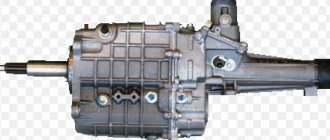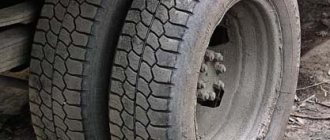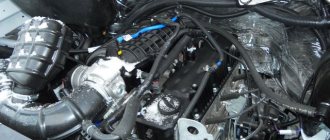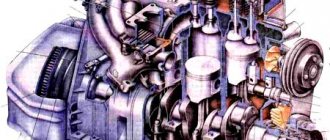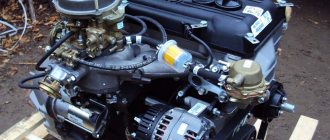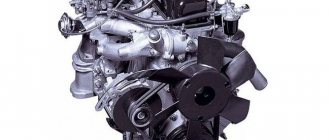Design features of the UMZ injection engine
The camshaft is connected to the crankshaft through a gear made of textolite or fluoroplastic. A metal washer is pressed into the gear rim; when it passes by the phase sensor, the position of the camshaft is recorded and a signal about this is sent to the control unit. Camshaft with lower location. The transmission of movements to the valves located in the upper part of the block head is carried out through durable rods made of aluminum alloy. The rods, which are in contact with the camshaft cams at the bottom and the rocker arms at the top, transmit movement to the valve stems, strictly in accordance with the profile of the cams and their angular locations.
The working part of the rocker arm is its profiled section, which, resting against the end of the valve stem, controls its opening and closing. The thermal gap between the working part of the rocker arm and the end of the valve is provided by an adjusting bolt or installed hydraulic compensators. Adjustment of thermal clearances is carried out on a cold engine with a temperature of no lower than 20 degrees and no higher than 30. Adjustment of the position of hydraulic compensators is also carried out in the range of these temperatures, and the adjustment procedure is similar to the regulation procedure without hydraulic compensators.
Gazelle problem in the cylinder head gasket of the UMZ 4216 engine, replacement of the timing gear.
. Replacing the cylinder head gasket for UAZ engine 402. My group is in contact.
Crankshaft 4216 consists of four connecting rod journals and five main connecting rod journals, and has the following diameters:
- molar necks – 64 mm;
- connecting rod journals – 58 mm.
All journals are equipped with two steel-babbit liners; the factory tolerance for crankshaft dimensions is 0.013 mm. Cylinder head cylinder head UMZ 4216 with gasket replacement UMZ-4216 Gazelle engine. During the repair of a Ulyanovsk engine, the main and connecting rod journals are measured with a micrometer - if they are worn more than 0.05 mm, the shaft must be ground. burnout of the cylinder head gasket. Replacing the gasket did not give any results. Umz 4216 E-3. The diameter of the piston pins is 25 mm, the pins are installed in bronze bushings of the connecting rods. Over time, both the pins themselves and the bushings may wear out; if play appears in the connection, the parts must be replaced.
The crankshaft in the cylinder block is mounted on supports with covers that are tightened with bolts with a certain force. Replacing the cylinder head (gasket) with a non-standard Gazelle 402: 1170:. Each cover has its own place - they cannot be mixed up, especially not picked up from another BC. Also, the covers must be secured to the lock - if they are installed incorrectly, the crankshaft may not turn (it will jam), and even if the shaft does turn, the engine will quickly fail.
Malfunctions and solutions
Fuel system
Signs of a fuel system malfunction:
- The engine will not start;
- prolonged engine start;
- the engine starts and stalls;
- lack of traction and dynamic characteristics;
- increased fuel consumption;
- frequent popping noises caused by a lean mixture;
- failures during acceleration.
One of the most common fuel system malfunctions is the ineffective operation of the fuel pump or its complete failure. It is possible to evaluate the operation of the fuel pump by connecting a pressure gauge to the injector rail. When the fuel pump is turned on, the pressure gauge needle should quickly, within 1.0 - 1.5 seconds, settle to the position of 3.8 atm, and when turned off, the pressure is allowed to drop to 3.0 atm.
If the pressure from the zero position increases slowly to 3.8 atm, this indicates that the filters installed in the tank on the fuel pump module and on the car frame are dirty.
A rapid drop in pressure to zero after turning off the fuel pump can be caused by a number of reasons:
- malfunction of the fuel pressure regulator installed under the fuel pump module cover%
- malfunction of the check valve on the fuel pump motor;
- the appearance of a crack in the corrugated fuel supply pipe to the main line or its leaky fit into the engine inlet fitting.
Fuel pump module
Failure of the fuel pump often occurs due to the lack of supply voltage, which is supplied from the switching relay. The relay is located in the engine compartment, on the rear wall of the engine compartment (literally under the windshield). Since the fuel pump relay is installed in the same block with two other relays for turning on the cooling fan and the main one, the car owner often has a question about their exact identification.
This can be done in different ways:
Method-1. Performed with an assistant without a warning lamp. The method works by sensing the activation of the relay electromagnet. The tester places his fingertips on all three relays, and the assistant turns on the ignition. At this time, two relays will operate simultaneously - the main one and the fuel pump, and the inspector will feel the click of the operation of the electromagnets. After 5-8 seconds, the fuel pump relay will turn off with a click of the relay, which will also be reflected on the inspector’s finger.
Method -2. Performed with an assistant and using a test lamp. Having hooked one of the test lamp probes to ground, the other is connected from the reverse side of the block to terminal “87” of the supply voltage. The assistant turns on the ignition and the inspector determines by the indicator lamp that one of the three relays is turned on. After 5-8 seconds have passed, at the relay where the control lamp turns off, this is the fuel pump relay. On the main relay, the control lamp will remain on continuously until the ignition is turned off, and on the fan relay, the lamp will not turn on.
The method is convenient in that the fuel pump relay is simultaneously detected and the presence of supply voltage is diagnosed by a control lamp.
Method-3. Performed without an assistant. The method is designed to identify the fuel pump relay based on the color scheme of the wires. On all Gazelle cars (ZMZ, UMZ engines) the outgoing wire from the fuel pump relay connector (pin “87”) is white.
Fuel pump relay (left)
If, during the check, the integrity of the wiring is established and there is voltage and ground at the fuel pump connector, then it is recommended to remove the fuel pump module from the tank and carefully inspect all existing contacts for burning. Sometimes a defect is detected instantly by the state of the melted motor.
Based on the results of checking the fuel pump, its normal operation is established, but the engine does not start or runs unbalanced after starting.
In this case, it is necessary to check the integrity of the electrical wiring harness connecting the injectors to the main cable and the control unit, check for the presence of positive voltage at all injector connectors, as well as incoming switching pulses when cranking the starter.
Missing pulses at the injector connectors with a simultaneous absence of a spark at the spark plugs indicates a malfunction of the synchronization sensor, the signal of which can be determined by diagnostic equipment.
The movement of the car is accompanied by jerks or dips
Sharp or short-term jerks that appear while driving most often occur due to sparking failures. Due to the inertia of fuel combustion, short-term and sharp jerks due to a malfunction of the fuel system are not possible and the main attention should be focused on checking the spark plugs, high-voltage wires and the correct operation of the ignition coil. It is impossible to check the failure of sparking, breakdown of high-voltage wires and turn-to-turn short circuits on the ignition coil on your own, without the presence of diagnostic equipment. The problem can be solved by simply replacing known good parts of the ignition system.
What does a specialist see when looking for jerks made by a car while driving?
The processes of spark formation to ignite the fuel mixture in the cylinders occur at enormous speeds, in other words, these are fleeting processes and it is possible to record (“catch”) the point of loss of spark only with special devices, oscilloscopes, which can record information frame by frame after a given and very short period of time (in milliseconds and microseconds).
Normal spark burning
Defect - no spark
The left figure shows an oscillogram of a normally operating spark. From left to right - switching is turned on in the primary circuit of the ignition coil and a charge occurs, which, upon reaching time, releases the accumulated energy to the electrodes of the spark plug in the form of a high-voltage breakdown, which reaches 10.0 kilovolts. The breakdown instantly goes into spark mode (horizontal line), which operates at a voltage of 2.0 kilovolts. The spark burning section ends with wave-like damped oscillations, indicating the serviceability of the ignition coil (residual high-voltage voltage).
In the right figure, the oscillogram before the discharge breakdown is recorded in the same way by an oscilloscope, but then there is no horizontal section of the spark burning line. This is the jerk of the car in motion.
Jerking on a car with a UMP engine may also appear due to a malfunction of the synchronization sensors, while the emergency malfunction lamp on the instrument panel may not turn on. In this case, it is easier to replace the synchronization sensors.
Failure often occurs due to a malfunction of the ignition coil, which is independently determined by replacing a known-good coil or by a specialist using special diagnostic equipment.
UMZ-4215.10. Removing the cylinder head and replacing its gasket
Tightening procedure for cylinder head bolts
Disconnect the battery. Drain the coolant (see Replacing the coolant). Remove the fine fuel filter (see Removing and disassembling the fine fuel filter). We remove the exhaust pipes (see Replacing exhaust pipes). Remove the carburetor (see Removing the carburetor). Loosen the clamp.
..disconnect the vacuum brake booster hose from the intake manifold.
Using a 10mm wrench, unscrew the fastening bolt and disconnect the earth wire from the intake manifold.
We remove the tips of the high-voltage wires from the spark plugs.
If necessary, turn out the spark plugs; it is better to do this with the head not removed (see Replacing spark plugs).
We move the crankcase ventilation hose to the side.
The revolutions fluctuate and can increase arbitrarily
In the case when all cylinders of the UMP engine operate in a wave-like cycle, i.e. At the same time they increase their energy intensity and also at the same time reduce it; there is a floating of revolutions in a wide range. It should be noted that an increase or decrease in speed (discreteness) is allowed in the range from minus 40 to plus 40. A value above the maximum permissible indicates a malfunction, which is most often caused by the leakage of unaccounted air into the intake manifold. Air leaks may appear on the bottom of the injectors, the sealing rings of which crystallize over time, in other words, “tanner” and, accordingly, the tightness is lost. As a result, unaccounted air penetrates through worn o-rings into the intake tract and the fuel mixture ratio is disrupted. Violation of the air-fuel ratio leads to floating speed and its regular increase with a subsequent drop.
It is difficult to check for air leaks on your own, and the advice of “experienced” people in searching for leaks with water or carburetor cleaner for suspected fistulas is not realistic. Water and spray from carburetor cleaner on a hot engine instantly evaporate and it will not be possible to create a film that temporarily covers the suspected fistula, especially if there are many such fistulas (four injectors, an intake manifold gasket, rubber tubes).
An effective way to check for air leaks is to fill the intake tract with smoke using a diagnostic smoke generator. This device can detect even very small air leaks in the most difficult to reach places.
Smoke generator
Reviews from car owners
There are the most controversial reviews about the UMZ 4216 engine - some Gazelle owners praise UAZ engines and believe that they:
- have good traction;
- consume fuel moderately;
- inexpensive, and easy to repair.
Indeed, the UMZ 4216 engine is very simple, especially since it has significant similarities with the ZMZ-402 internal combustion engine. Cylinder head UMZ 4216 Mir3302 auto parts and accessories for Gazelle cylinder head UMZ 4216 gasket replacement. The design of the power unit is familiar to many drivers, and such an engine can be repaired almost in the field. Some difficulty for car owners is the electronic equipment of the engine - after all, the injector is somewhat more complex than a carburetor device.
You can also hear extremely negative responses from owners of Gazelles with UAZ engines:
- the engine is prone to overheating;
- Sensors often fail, so the engine starts to stall and not move;
- The engine consumes oil, it leaks from wherever possible.
Unfortunately, a lot of defective products come from the Ulyanovsk plant, and mostly those drivers who have received a defective internal combustion engine complain about the Ulyanovsk engine. Independent replacement of the cylinder head gasket of a VAZ 2112 16. There are several characteristic ones that are quite often found on the UMZ 4216:
- the intake manifold cracks and begins to suck in air;
- the pump does not provide the required oil pressure;
- the electromagnetic cooling clutch refuses to work, and the motor begins to overheat.
Drivers of such unsuccessful Gazelles note that the engine often has to be “modified with a file.” It has also been noticed that if the engine is completely rebuilt with your own hands, breakdowns occur much less frequently, the main thing is to assemble the engine using original good quality parts.
Fuel consumption has increased, power has decreased and it often stalls.
If malfunctions associated with a decrease in engine power, an increase in fuel consumption and unbalanced engine operation simultaneously appear, you should first look for the cause in the correct operation of the gas distribution mechanism, which on the UMP engine is very sensitive to thermal valve clearances. The owner needs to remember at what mileage the technical regulations for adjusting the thermal clearances of the valves were carried out and precisely at the mileage, and not in winter or summer. Adjustment of clearances on the UMP engine is carried out according to the manufacturer’s instructions and is recommended to be carried out every 10 thousand kilometers.
More details about adjustment
Various modifications
It should be noted that the UMZ 4216 engine produced for Gazelle Business is one of the modifications of the UMZ 421 engine series. It has been produced since 1993 and has models: 4213, 4215, 4218.
As for the UMZ 4216 engine itself, we can say that there are separate modifications for it, among them:
- 4216.10 – power 123 horsepower. Complies with Euro-3 standard. Made for 92 gasoline.
- 42161.10 - a weaker version with a capacity of 99 horsepower.
- UMZ 42164.10 - power is 125 horsepower, and the engine itself complies with Euro-4 requirements. UMZ 42164 is the most powerful and at the same time environmentally friendly among all the given motors.
- 421647.10 – gas-gasoline engine with a capacity of 100 horsepower.
- 42167.10 – gas-gasoline engine with a power of 123 horsepower.
UMZ 4216 Euro 4 itself, which allows us to talk about its quality.
Difficulty starting the UMZ engine when cold
The issue of cold starting is problematic both for specialists and for the car owner. This situation arises due to the fact that the car arrives for diagnostics with a hot engine, and when it is hot it starts just fine. The owner cannot check a cold engine on his own due to the lack of diagnostic equipment.
However, there are a number of important reasons why the UMP engine is difficult to start when cold:
- low compression in cylinders;
- low fuel pressure in the injector rail;
- valve thermal clearances do not meet specifications;
- wear of spark plug electrodes;
- nozzles are not tight;
- faulty coolant temperature sensor;
- leakage and mixing of gas (propane, methane) with gasoline at the time of startup;
- Absolute pressure sensor malfunction;
- malfunction of the mass air flow sensor (if included);
- presence of water in the tank.
It should be noted that experts identify some of the listed defects on a hot engine, but even after they are eliminated, the question remains open until the next time the engine is started on a cold one.
Description of the engine by components
It should be noted that some characteristics may differ slightly, however, only the engine power is subject to variation, and the remaining design characteristics are similar to each other.
- The number of crankcase cylinders is 4 pieces.
- The sequence of arrangement is one after another in the same row.
- The plunger size is 100 mm (or the outdated 92 mm).
- Engine displacement is just under 3 liters.
- The compression ratio present in the cylinders is 9.2.
- The amplitude of movement of the plunger is 92 mm.
- Engine power – from 100 to 125 hp. (depends directly on the modification of the device).
- Maximum torque – 235 Nm.
- Total torque – 221 Nm.
- Fuel consumption in the city is 10.4 l/100 km, on the highway – 11.2 l/100 km.
- Operating mode at full torque – 2200 – 2500 rpm.
- At idle speed - 800 rpm.
- Injection supply - controlled by a special microcontroller.
- Recommendation for fuel use - 92nd possibly 95th gasoline;
- Engine classification regarding the fuel used - Euro-3 or Euro-4 (depending on the model).
Recommendations for long-term operation of the UMP engine without repair
Unlike the ZMZ-405 engine, the 16-valve UMZ-4216 (and similar series) works flawlessly, is durable and resistant to operation on gas (propane, methane). Of course, after continuing the modernization and installation of hydraulic compensators, the engine often began to ask specialists for diagnostics. Hydraulic compensators installed on the gas distribution mechanism rods are the only weak link of this engine, but this can be easily solved by replacing the rods and adjusting bolts without hydraulic compensators.
Otherwise, if the maintenance requirements are met, the motor will operate stably and with proper dynamic performance.
Timely adjustment of the thermal clearances of the valves, cleaning the air path of the throttle assembly, chemically washing the injectors with simultaneous decarbonization of the CPG, periodic maintenance of the fuel tank with a moisture displacer (isopropyl, medical, technical alcohol), replacing all filters included in the package - this is the key to the successful operation of a commercial vehicle. transport.
